Free water, housing, food: Modi's $400bn welfare bet to win Indian elections
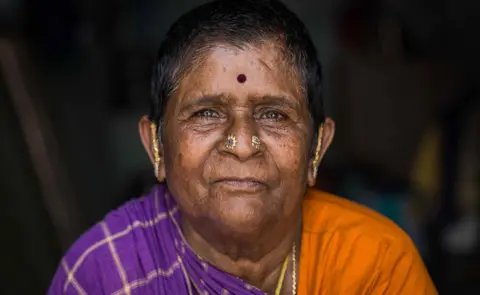 Bimal Thankachan
Bimal ThankachanBalaram Bhallavi and his family might finally get a proper roof over their heads.
For years, a tiled shanty in a sun-drenched village in India's central Madhya Pradesh state has been home to Mr Bhallavi, his wife, and their four school-going children. A strip of a mud-floored foyer packs in a kitchen, a few plastic chairs, two rope beds and fraying clotheslines.
After a three-year wait, the Bhallavi family received 120,000 rupees ($1,445; £1,136) from a programme run by Prime Minister Narendra Modi's government last year, allowing them to start building a new home.
More than 25 million homes have been built since 2016 under the rural public housing programme, called the Pradhan Mantri Awas Yojana (Prime Minister's Housing Scheme). It is one of the more than 300 federal schemes that Mr Modi is leaning on to bolster support for his Bharatiya Janata Party (BJP) during the general election as he eyes a record-equalling third term in office.
"Life is tough. But I am grateful to get money from the government to build my first house," Mr Bhallavi, 42, said.
After coming to power in 2014, Mr Modi has expanded India's welfare programmes, targeting women and farmers in particular. This includes providing cooking gas, free grain, houses, toilets, piped water, electricity and bank accounts, and beefing up a long-running jobs guarantee programme.
Many benefits - pensions, subsidies, loans and scholarships - are delivered through cash transfers to bank accounts linked to biometric identity cards held by over a billion Indians. Giant posters of Mr Modi promoting these schemes as his personal "guarantees" dominate the landscape.
Mr Modi says his government has spent more than 34 trillion rupees ($400bn; £316bn) in the past decade, delivering direct cash benefits to low-income households and reaching over 900 million people. A yearly handout of 6,000 rupees to more than 110 million farmers constitutes one of the world's largest cash transfer programmes. The transfers, officials claim, have cut corruption and slashed costs.
Economist Arvind Subramanian calls this Mr Modi's "New Welfarism", funding essential private items like toilets, rather than expanding public goods such as primary education and healthcare.
To be sure, "New Welfarism" stands apart from the traditional welfare models in Europe or the US.
While the US tends to favour smaller government and lower taxes, resulting in modest social transfers, European welfare states have been more generous. Social democracies such as those in Scandinavia have favoured higher social spending, supported by higher taxes.
Following Mr Modi's cue, all parties in India have caught what Devesh Kapur of Johns Hopkins University calls the "virus of cash transfers with numerous schemes across states and political parties".
The country's state governments now operate more than 2,000 cash transfer programmes. "Every party in India knows that welfare matters for votes," says Mr Kapur.

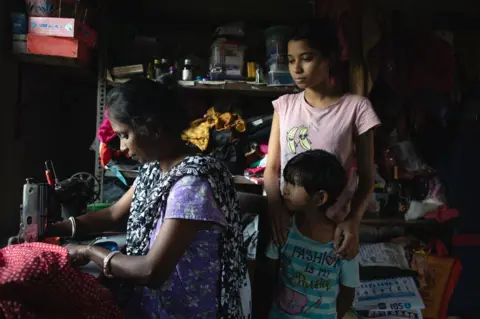 Swastik Pal
Swastik PalOn a recent balmy morning in Bishnupur in West Bengal state, more than a hundred men, women and children gathered under a blue-and-white tent in a school courtyard. The event had a festive air about it.
Except this was a welfare delivery camp organised by the ruling Trinamool Congress party, led by Mamata Banerjee, a charismatic regional leader who has so far repelled Mr Modi's BJP in the eastern state, home to over 100 million people.
Serving her third term, Ms Banerjee has prioritised welfare initiatives, running some three dozen schemes. These include free bicycles to get to school, scholarships for girls, financial aid, pensions for women, the elderly and the disabled, alongside universal health insurance.
"We are giving welfare benefits here from birth to death," Naziruddin Sarkar, a senior district official, said.
To ease the burden of travelling to distant government offices and dealing with unhelpful officials, Ms Banerjee's government operates a benefits outreach programme called 'Duare Sarkar', meaning 'government at your doorstep'. In the last three years alone, over 100 million people have registered for welfare benefits across different schemes at more than 650,000 such camps in 23 districts, according to official data.
The camp in Bishnupur offers a snapshot of the livelihoods of beneficiaries.
Shobha Mondal says she is using her widow's pension to send her son to school. Monika Tithi uses three separate pensions - as a farmer, tribesperson and woman - to run a village grocery. Dipali Mondal, another widow, uses her pension to make and sell street-side snacks.
"When old or widowed women get money, they are respected more in their household. Pensions give them dignity," Choten Dhendup Lama, a senior official, said.

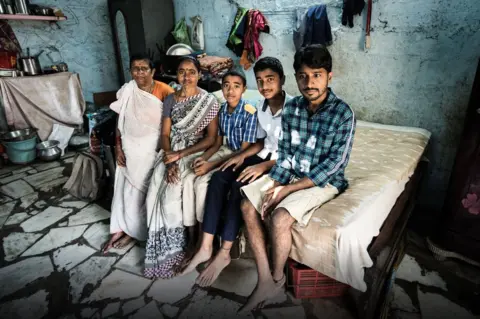 BIMAL tHANKACHAN
BIMAL tHANKACHANHundreds of miles away in the coastal city of Visakhapatnam in southern India's Andhra Pradesh state, Y Laxmi pins her hopes on welfare to secure a brighter future for her children.
She lives with her deaf and speech-impaired husband, their two school-going sons, and her widowed mother-in-law. They rely on handouts totalling 6,000 rupees every month, from her husband's disability and her mother-in-law's widow's pensions, to run the household.
The state government under YS Jagan Mohan Reddy, leader of the YSR Congress Party, funds more than two dozen welfare programmes. They include aid for women's self-help groups, even monthly payments to kidney patients for dialysis.
The potential game-changer is the Amma Vodi or Mother's Lap scheme which provides support of 15,000 rupees annually, that mothers like Ms Laxmi get to send children to school. Her 17-year-old son, Vamsi, aspires to go to the Indian Institute of Technology, the country's top engineering school.
"The money from the government will hopefully help in realising his dream," Ms Laxmi said.

Mr Modi inherited India's welfare system - free food, electricity and farm subsidies, rural housing and a rural jobs programme - and made it bigger.
Surveys show voters identify welfare programmes with the ruling parties, and that the number of households reporting using clean cooking fuel, toilets and women's access to bank accounts has increased since Mr Modi came to power a decade ago. Distributing free bicycles to girls attending schools and colleges in various states has increased access to education.
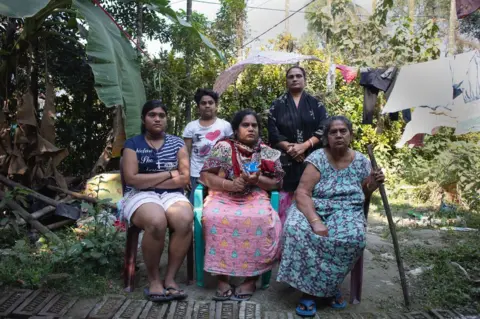 Swastik Pal
Swastik PalBut evidence of welfare translating to votes is more mixed. Victories in Indian elections aren't solely determined by a single factor - caste, demography and religious identity are other key predictors of support for a party.
In 2019, a survey by polling group Lokniti-CSDS, found that the BJP had attracted more women voters in that year's general elections, because of a rise in Mr Modi's popularity and the impact of welfare schemes. Yet, a recent study in West Bengal concluded that "ideology and identity politics" outweighed welfare considerations in explaining the growing popularity of the BJP in the state.
Last year, amidst mounting allegations of corruption, the BJP lost elections in Karnataka despite a slew of welfare programmes. In Andhra Pradesh, a state known for its high social mobility, there's scepticism whether welfare initiatives alone will suffice for Mr Reddy to win this summer, given a lack of jobs and poor infrastructure. Many grumble that welfare undermines work ethic.
"Leaders have benefited politically from the programmes. But over time, there are diminishing returns. Governance and other things begin to matter more," Mr Subramanian said.
He also cautions against "competitive populism", emphasising the strain of too many welfare schemes on public funds. India's public debt - of federal and state governments - exceeds more than 80% of GDP, according to IMF data. Last December, in a report, the IMF flagged India's "elevated public debt levels and contingent liability risks".
"States are playing with fire," said Mr Subramanian. "These schemes have become permanent entitlements. I don't know how this will end."
The jury is still out on whether 'New Welfarism' is hurting the exchequer. And experts also warn that these schemes aren't enough to lift people out of poverty; investments in healthcare and education are also essential.
Then there are slippages in the much-hyped programmes. In Visakhapatnam, despite receiving ample handouts, Ms Laxmi's family spends a fortune buying drinking water because of the lack of a water connection, and go to a neighbour's apartment to use the toilet because they have none.
Also, inflation and falling incomes could often mean that welfare has its limits. Mr Bhallavi, who got a handout to build his house in Madhya Pradesh, earns 500 rupees daily making brick homes. Despite owning a farm, freak weather and high fertiliser prices have made farming unviable.
He said he would also need to top up the housing handout and borrow an additional 80,000 rupees at a 12% annual rate from the village money lender to construct his house, underscoring the continuing challenge of accessing affordable formal credit.
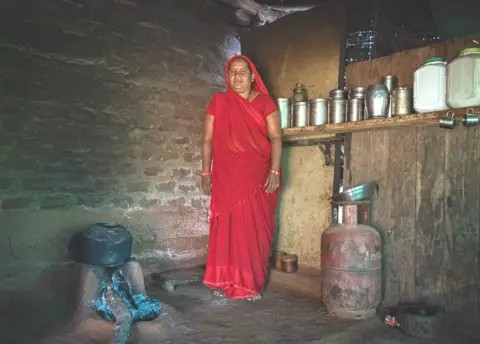 Bimal Thankachan
Bimal ThankachanHis wife, Lakhpati Bai, said that despite benefiting from subsidised cooking gas for two years, they struggle to refill their free cylinder due to rising gas prices. "We do most of our cooking on the clay stove," she said.
In 2022, India's Home Minister Amit Shah defended his government's approach to welfare.
"We have given gas connections, power connections and it's up to them [people] to pay their bills. We have made toilets for them but they have to maintain them... What we did was to provide help to upgrade their lives - this is empowerment," Mr Shah told The Indian Express newspaper.
India spends less than 1% of its GDP on health, and spending on education has been slashed. Extending the free grain programme to over 800 million people until 2028 also points to a struggling rural economy. Mr Kapur believes cash transfers have "become an easy short-term solution and harder long-term solutions like investing adequately in agriculture, education and healthcare are being neglected".
"All that requires institution building, which is a hard slog. So while there is much that is commendable about the New Welfarism, one worries that it might be at the cost of building systems that matter for long-term productivity and growth," he said. Most Indians would agree.
Videos by Bimal Thankachan
All pictures are copyrighted

